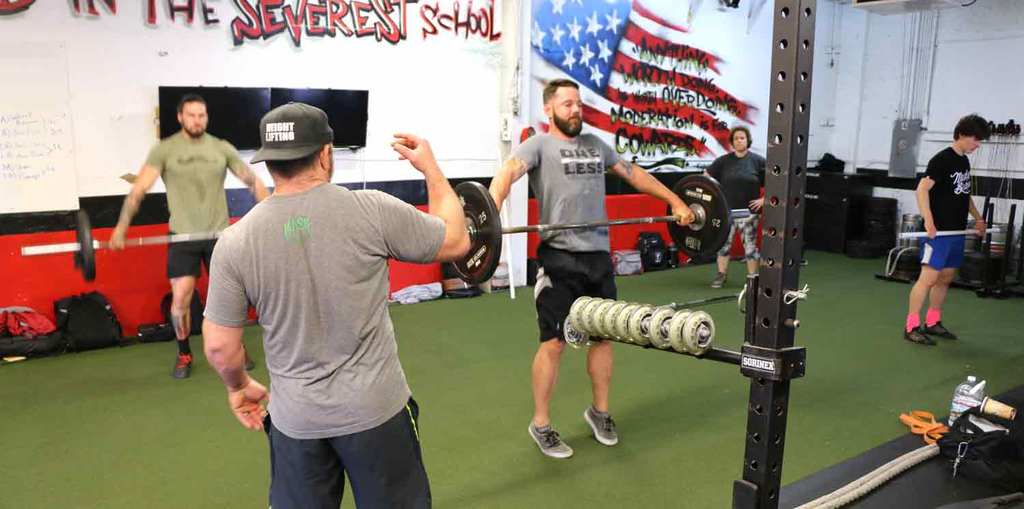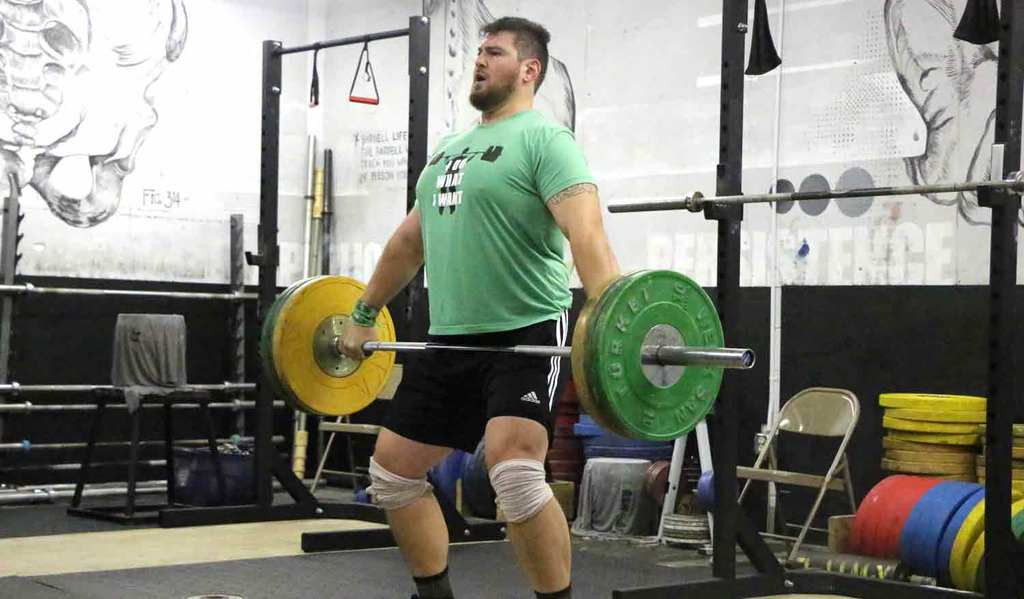Which weightlifting movements should coaches use for athletic performance? Are they even necessary?
This is one of my favorite debates because it can go on and on. Some coaches feel that the Olympic lifts have to be used in a strength and conditioning program for a program to be legit. Other coaches feel that the snatch and clean and jerk are too hard to teach and carry too much risk of injury. So who’s right?
The easy answer is that a program can be successful using just about any choice of movements. If you don’t agree, all you have to do is look around the country. Programs have been successful using the Olympic lifts, and programs have been successful without the Olympic lifts. The real key is choosing movements the strength coach and his or her staff feel comfortable and proficient teaching to their athletes.

KEY MOVEMENTS
Yesterday I asked a question on Twitter, “If you could only use five movement to train all of your athletes, what five movements would you choose?” The answers varied from person to person with a form of barbell squat (front or back) being the most common. Personally I would choose:
- Clean and all variations. These deliver power production and velocity.
- Back squat. Squats increase lower body strength and core stabilization. Not to mention the research states that vertical leap and improvements in speed are more closely related to the squat than any other movement in the gym.
- Push press. The push press is the most functional way of demonstrating upper body strength because the power originates from the lower body. For example, a football player blocks their opponent with force originating from the hips ending with an explosive punch in the arms.
- Deadlift. Just like the squat, the deadlift can be linked to improvements in athletic feats like the vertical leap and 40-yard dash. I also chose the deadlift to strengthen the posterior chain to promote symmetry when used with the back squat.
- Barbell bent-over row. This was a hard choice between rows and pull-ups. However, it’s just a bit easier to load a row. A strong back is imperative for any athlete. The barbell row is particularly useful due to the stability component necessary of the spinal extensors to maintain the hinge position of the bent-over row.
One more thing I would like to note is the importance of spine stabilization from pretty much all of these movements. If you want to protect the spines of your athletes, you need to strengthen all of the muscles around the spine – especially all the muscles that extend the spine. The abdominals help, but it’s the spinal extensors that keep the spine locked in neutral. Deadlifts do a great job of strengthening the back, hips, legs, and neck. That’s what makes the deadlift the best bullet proofing movement in the gym (as Dan John says). Have you ever seen a good deadlifter with a small neck and traps? I haven’t.
WITHOUT THE OLYMPIC LIFTS
I love the Olympic lifts. Of course I do – I coach some of the best weightlifters in the country. But if someone isn’t proficient at teaching the movements, then they shouldn’t add those movements in their program no matter how good they are. A movement is only beneficial when used correctly. If I didn’t understand how to teach the Olympic lifts, I could still create a program that would deliver athletic improvement. I could use the following movements:
- Squat variation
- Deadlift variation
- Push press
- Bent-over rows
- A type of carry (farmer’s walk, Zercher, overhead, etc.)
- Squat jumps or another type of plyometric
I could use these movements along with a closer look at velocity, and I could cover every quality of strength required to maximally improve any athlete. With that being said, I want to talk about the use of the different variations of the Olympic lifts specifically: full lift variations, hang variations, power variations, and block variations.
[thrive_leads id=’9126′]
Full Variations
The full snatch and clean are great for total athleticism. You’re going to get power production, proprioception, balance, coordination, mobility, and force absorption. I’ve never seen a bad athlete complete a full snatch. When a person learns a snatch, they have learned to produce power, move their bodies through space, and move quickly (speed). They’ve also developed incredible mobility. All of these characteristics are important to athleticism.
There are challenges and maybe even some drawbacks to the full variations. For one, these movements take a bit longer to learn. They’re complex in nature, so they take a little extra time. And in the world of strength and conditioning, time is valuable. Remember we are talking about non-weightlifting athletes. Their sport isn’t Olympic weightlifting.
HANG VARIATIONS
This is probably my favorite because it mimics the countermovement of a vertical leap. You are going to receive a stretch reflex just like when you jump. Plus this is the one variation that begins with an eccentric contraction, which is great for hypertrophy and strengthening the movement. The range of motion involved in the hang variations is more specific to sprinting and jumping as well. Nowhere on the field (football, soccer, basketball, or baseball) are you asked to perform a full squat. I’m not saying that there aren’t benefits to a full squat catch, but the specificity of the hang movements will normally yield a higher return to sport specific requirements. When you catch the hang movements in a power position (above parallel), you have the most specific movement in the gym.

POWER POSITIONS
This refers to the catch of the snatch and clean being above parallel. I already talked about this position regarding the hang movements. I like the power movements because they are a bit easier to teach. I also like the fact that they require the athlete to move faster. Everyone thinks that power movements are all about how high they pull the bar. I’ve got news for you. All you can control is the velocity of the bar. You pull it as hard and as fast as possible. When your hips extend, the height of the bar is already determined. There is nothing you can do to pull the bar any higher after the hips extend.
If you want to get good at power cleans and snatches, the focus needs to be on:
- Timing
- Speed of the third pull
- Strong catch (force absorption)
To get good at power movements, timing is crucial. If you waste any time at the top, you will miss the peak of the bar. You will find yourself pulling under while the bar is on the way down. The biggest reason I prescribe power movements for my weightlifters is to get them better at timing. Timing is crucial to be good at the sport. Timing isn’t necessarily important for non-strength athletes, but it helps in being able to handle higher loads.
Obviously speed is important to all athletes. In a perfect world, the barbell should move faster throughout the movement – with the third pull (the pull underneath the bar) being the fastest. The power movements require athletes to move quickly, so it teaches speed without the athlete actually thinking about it.
The strong catch is the quality that transfers to athletes the most because it requires the athlete to absorb large amounts of force in an abrupt manner. When you think about football or rugby, it’s easy to see the benefit of power cleans and power snatches. When you add the velocity required for power movements to the force absorption, you have a very functional movement for just about any sport. Plus the catch height of the snatch and clean is at a position that is much more specific to other sports, such as softball, baseball, football (linebacker, running back, etc), or even soccer.
BLOCK VARIATIONS
I like variations from blocks for a lot of the same reasons as above, and they have one advantage regarding specificity. Block cleans and snatches begin from a dead start, which is specific to sprints. There isn’t a countermovement with sprinting. With block cleans and snatches, the movement begins from a dead stop. This teaches the athlete to generate force as quickly as possible and is a great way to improve the rate of force development. Let’s face it: sport is played at a fast pace. Athletes are asked to go from 0 to 100 as fast as possible. The athlete who can react and get to full speed at the fastest rate will end up being the best athlete. Blocks can be done from whatever height is the most specific or from the height that is the weakest.
For specificity reasons, I would say that hang powers and block powers are the best movements for directly affecting athletic performance. I recommend using hang powers to improve vertical leap and broad jumps. Hangs are also good for improving elasticity, strengthening position, and tendon strength. Block powers are great for improving sprinting times especially the start and acceleration portions.
THE REAL MUST-HAVES
There’s a place for all the Olympic variations, including the jerk. But if I had to choose two variations, I would use hang powers and powers from blocks. I hope this helps some of you strength and conditioning coaches decide which movements to use and when to use them. Remember, there isn’t a movement that is an absolute must-have for any program. Coach Mike Boyle has made a career out of getting athletes better without bilateral squats or cleans, so obviously you don’t have to use those movements. I recommend squats and cleans, but you don’t have to use them.
The only must-have I require of all my coaches is that they know the why for each and every movement they program. If you don’t know the reason for a movement, then drop it from your program. As a coach, you should be excited when one of your athletes asks you why you’ve programmed the way you have. It’s a chance to teach them and get buy-in. Coaches, do your homework and know the why behind your program.
[thrive_leads id=’8207′]
I really enjoyed this article to get a taste of what you’re thinking of in regards to carryover in sport (outside of weightlifting). I also appreciated the articulation of using block movements for force production. That is an interested approach that I had never thought of, but one that I will definitely experiment with more.